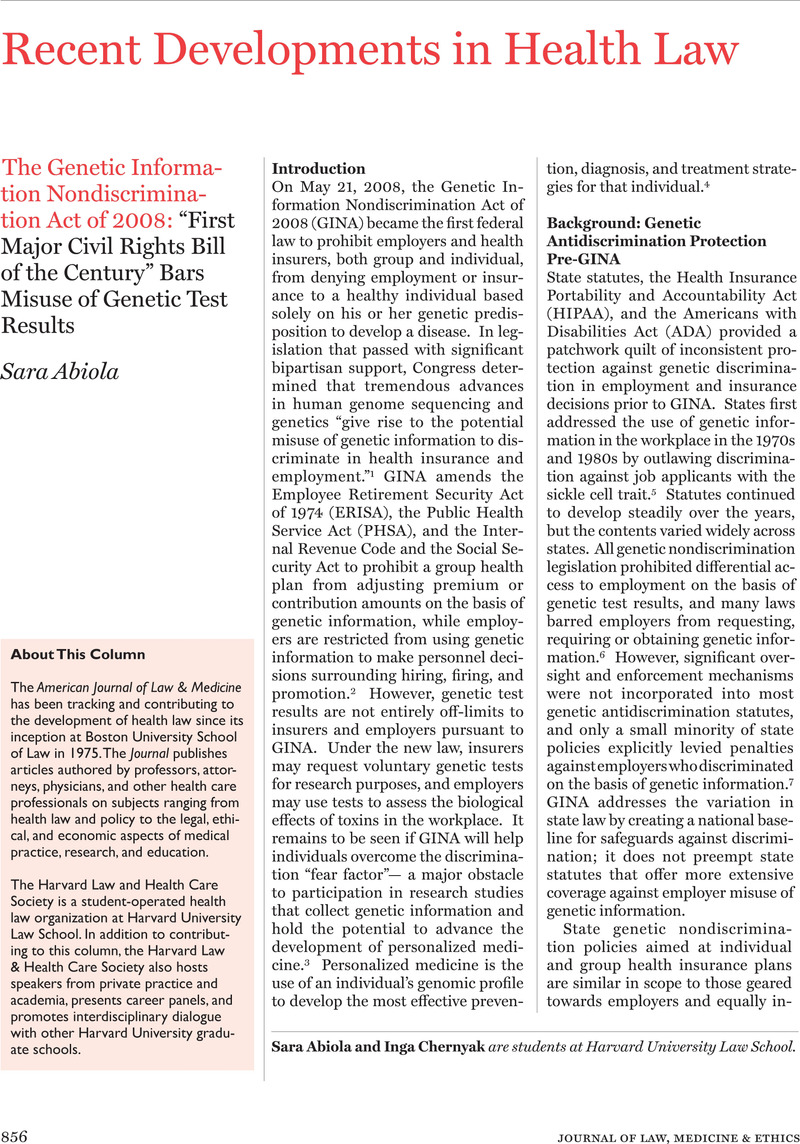Crossref Citations
This article has been cited by the following publications. This list is generated based on data provided by Crossref.
Botkin, Jeffrey R.
2010.
Informed Consent for Genetic Research.
Current Protocols in Human Genetics,
Vol. 66,
Issue. 1,
Phibbs, Fenna T.
and
Hedera, Peter
2010.
UPDATE ON THE GENETICS OF MOVEMENT DISORDERS.
CONTINUUM: Lifelong Learning in Neurology,
Vol. 16,
Issue. ,
p.
77.
Roberts, Maegan E.
Riegert‐Johnson, Douglas L.
and
Thomas, Brittany C.
2011.
Self Diagnosis of Lynch Syndrome Using Direct to Consumer Genetic Testing: A Case Study.
Journal of Genetic Counseling,
Vol. 20,
Issue. 4,
p.
327.
Brandt-Rauf, Sherry I.
Brandt-Rauf, Elka
Gershon, Robyn
and
Brandt-Rauf, Paul W.
2011.
The Differing Perspectives of Workers and Occupational Medicine Physicians on the Ethical, Legal and Social Issues of Genetic Testing in the Workplace.
NEW SOLUTIONS: A Journal of Environmental and Occupational Health Policy,
Vol. 21,
Issue. 1,
p.
89.
Tester, David J.
and
Ackerman, Michael J.
2011.
Genetic Testing for Potentially Lethal, Highly Treatable Inherited Cardiomyopathies/Channelopathies in Clinical Practice.
Circulation,
Vol. 123,
Issue. 9,
p.
1021.
Kang, Peter B.
2011.
Presymptomatic and Early Symptomatic Genetic Testing.
CONTINUUM: Lifelong Learning in Neurology,
Vol. 17,
Issue. ,
p.
343.
Snyder, Cindy
2011.
Genetic Information and Discrimination: A Policy Analysis.
Clinical Journal of Oncology Nursing,
Vol. 15,
Issue. 3,
p.
330.
Davis, Karen D.
Racine, Eric
and
Collett, Beverly
2012.
Neuroethical issues related to the use of brain imaging: Can we and should we use brain imaging as a biomarker to diagnose chronic pain?.
Pain,
Vol. 153,
Issue. 8,
p.
1555.
Maron, Barry J.
Maron, Martin S.
and
Semsarian, Christopher
2012.
Genetics of Hypertrophic Cardiomyopathy After 20 Years.
Journal of the American College of Cardiology,
Vol. 60,
Issue. 8,
p.
705.
Tester, David J.
and
Ackerman, Michael J.
2012.
Electrophysiological Disorders of the Heart.
p.
73.
Huang, Ming-Yi
Huston, Sally A.
and
Perri, Matthew
2013.
Awareness of the US Genetic Information Nondiscrimination Act of 2008: an online survey.
Journal of Pharmaceutical Health Services Research,
Vol. 4,
Issue. 4,
p.
235.
Tester, David J.
and
Ackerman, Michael J.
2013.
Electrical Diseases of the Heart.
p.
315.
Montecucco, Fabrizio
Carbone, Federico
Dini, Frank Lloyd
Fiuza, Manuela
Pinto, Fausto J.
Martelli, Antonietta
Palombo, Domenico
Sambuceti, Gianmario
Mach, François
and
De Caterina, Raffaele
2014.
Implementation strategies of Systems Medicine in clinical research and home care for cardiovascular disease patients.
European Journal of Internal Medicine,
Vol. 25,
Issue. 9,
p.
785.
Tester, David J.
and
Ackerman, Michael J.
2014.
Forensic Pathology of Infancy and Childhood.
p.
899.
Michels, Michelle
and
ten Cate, Folkert J.
2015.
Hypertrophic Cardiomyopathy.
p.
155.
POMERANZ, JENNIFER L.
2015.
Participatory Workplace Wellness Programs: Reward, Penalty, and Regulatory Conflict.
The Milbank Quarterly,
Vol. 93,
Issue. 2,
p.
301.
LAMPERT, RACHEL
2015.
Reassuring News for Genetically Tested, Appropriately Treated, Low‐Risk LQTS Patients.
Journal of Cardiovascular Electrophysiology,
Vol. 26,
Issue. 8,
p.
859.
Michels, Michelle
2019.
Hypertrophic Cardiomyopathy.
p.
189.
Botkin, Jeffrey R.
2020.
Informed Consent for Genetic and Genomic Research.
Current Protocols in Human Genetics,
Vol. 108,
Issue. 1,





